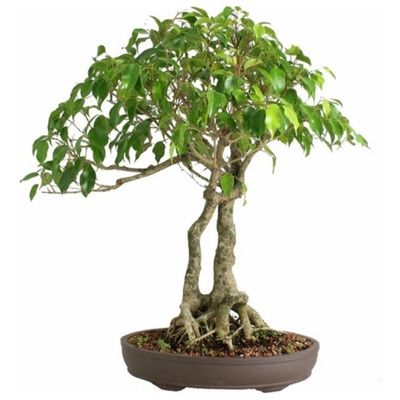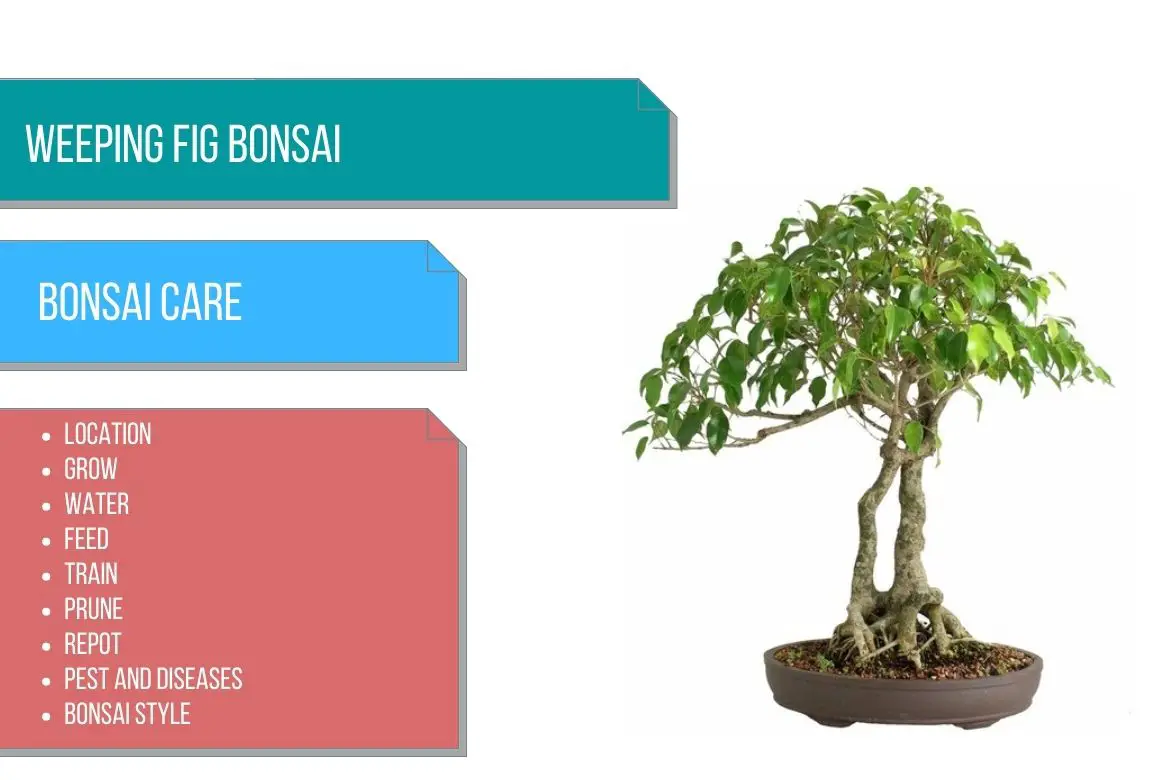
Weeping fig / Benjamin fig
( Ficus benjamina )
Country of Origin : South Asia
Bonsai Styles : Formal upright, Informal upright, group, raft, broom, raised root, root over rock
Zone : 9 – 12
Ficus benjamina, also called “weeping fig” (because of the shape of its crown and roots), is a rubber tree.
It is native to India and Malaysia, however it is now found and grown in almost every tropical region.
It is also known as “small-leaved fig-tree“. It is a tree with ovate leaves that are light to dark green in color and slightly wavy in shape. (Other name : Weeping Laurel, Small-leaved Rubber Plant)
The tree has a short trunk covered in smooth, silvery grey bark, and it has outstretched branches that are supported by dense aerial roots. Moreover, this tree has an elegant appearance due to its drooping branches.
This tree produces small, fig-shaped fruits that are green at first, but when they reach ripeness, they turn a blood-red color.
Among many other ficus trees used to make bonsai, the Ficus benjamina bonsai tree has gained a lot of popularity because of the tree’s tropical appearance and robust nature.
Furthermore, the weeping fig tree is often considered an excellent tree for making forest bonsai style.
Despite the fact that many varieties of weeping fig tree exist, their main difference is the size of their leaves.
The varieties which are particularly suited for making a bonsai are:
- Ficus benjamina ‘exotica‘ : Also sometimes called just ficus exotica. It is a dwarf variety and only grows 2-3 feet high and has leaves in a variety of shades of green and pink.
- Ficus benjamina ‘Natasha‘ : Another weeping fig variety which has beautiful pointy and shiny green leaves and compact growth habit.
- Ficus benjamina ‘Too little‘ : This is also a dwarf variety and grows about 10 inches. It has a compact growth habit and tiny leaves.
- Ficus benjamina ‘Variegata‘ : This variety has unique shiny green and white leaves.
These varieties are specifically suited to growing in low light conditions.
Throughout the year, they tolerate an indoor climate well and are easy to shape into beautiful bonsai trees. In this way, they also make great indoor bonsai trees.
Read more about other pine tree bonsai in : Bonsai tree care .
Best location to keep Weeping fig Bonsai
The Ficus benjamina bonsai tree can be kept indoors all throughout the year, just like all other Ficus bonsai trees.
During the winter months, keep the bonsai container above or near a radiator or on a window / window sill with bright light. The tree prefers its feet to be warm.
Keep it in a west or south facing window.
Weeping fig bonsai can also be grown outdoors in partial shade or full sunlight in mid-spring.
It should, however, be allowed to adjust to direct sunlight very gradually. Don’t make sudden changes to light levels.
When the bonsai is grown outdoors, the tree’s strength and compactness will increase.
Once the temperature drops below 60°F (16°C), bring the bonsai inside to a bright location and maintain temperatures between 59°F – 75°F (15°C – 24°C).
IMP: Refer sunlight requirements for indoor plants for more indoor gardening ideas. Also, refer to do bonsai trees need sunlight for more indoor and outdoor bonsai location ideas.

The tree can develop air roots when exposed to high humidity levels and warm temperatures, which will give the bonsai more of an interesting appearance.
To achieve such environmental settings, you can keep the bonsai in a warm greenhouse or a warm winter garden.
Propagation of Weeping fig
Weeping fig can be propagated by using stem cuttings.
As with all the fig trees, when pruned, the plant releases a sap which can cause some irritation of the skin. Hence, if possible, wear gloves to prevent getting in contact with the sap. (this is optional)
Take cuttings from new growth in spring (you can also take cuttings in summer). Put the cuttings in a jar of water. Keep changing the water regularly.
Keep it in a bright sunny location. You should see new roots emerging in about 3 weeks.
Air layering can also be done in mid-spring on large plants.
Watering Weeping fig Bonsai
The tree has leathery leaves and transpires less water through evaporation. Therefore, the plant requires less frequent watering.
Water the bonsai tree when the soil becomes slightly dry to the touch.
Generally speaking, the cooler the temperature is, the less watering needs to be done.
Do not over-water or keep the soil soggy.
You can use tap water that has been allowed to stand for some time.
Read watering bonsai tree for more details.
Wiring Weeping fig Bonsai
With the help of wires, it is very easy to shape branches because they remain flexible for a long time.
Despite the fact that wiring is possible year-round, it is only possible on branches that are lignified.
There is a tendency for branches to thicken very quickly, so it is important to keep an eye on the wire at all times.
The wires need to be removed after six to eight weeks to avoid them biting into the tree. This also depends on the growth rate of the tree. Sometimes it will take 3-6 months before you remove the wires and rewire the branches.
Extremely tight wires can cause damage and scarring that remains visible on the tree for a very long time.
Pruning Weeping fig Bonsai
When to prune Weeping fig bonsai?
How to prune Weeping fig bonsai?
This tree has relatively large leaves. Hence for the leaves to look proportional to the bonsai, the weeping fig bonsai tree should be allowed to grow to a height of 20 inches (50 cm) at least.
It is possible to prune branches throughout the year.
You should trim new shoots back to one to three leaves once they reach about 8 inches (20 cm), or when they have grown 6-8 leaves.
To encourage the development of lower branches, keep new shoots short in the top third of the crown.
This tree tolerates leaf pruning well, but should only be pruned during the main growing season.
Regardless, excessively large leaves should always be removed.
In order to keep a tree compact, it is often necessary to cut back to the old wood. After being pruned in this way, the plant quickly produces new shoots.
There is no need to be concerned about the white sap on the cut surface since it helps to heal the wound.
Repotting Weeping fig Bonsai
When to repot Weeping fig bonsai?
Weeping fig bonsai can be repotted every 2 years in spring.
Do some root pruning while repotting. However, do not remove more than 1/3rd of the total root system.
You can use a free-draining, bonsai soil mix as a potting soil.
Or a mix of Sand, loam and peat moss in the ratio of 1:1:2.
Or a mix of sand, compost and clay particles in the ratio of 1:1:1.
Must Read: Bonsai Soil Recipes
Must read : Choosing the right bonsai container
Feeding Weeping fig Bonsai
From spring to fall, you should use liquid bonsai fertilizer every fortnight.
Fertilizer should be used every four to six weeks during the winter, but only if the plant is in a warm location.
Read more about bonsai fertilizer and its application.
Diseases and pest of Weeping fig Bonsai
Infestations of scale insects can occur on weeping fig bonsai.
Yellow speckling on the leaves is caused by spider mite infestations, but foliage loss does not occur immediately.
It is possible for weeping figs to survive with a certain amount of mite infestation as well. Plant development will, however, be slowed down.
You can apply horticultural oils or Neem oil to reduce the infestation. Sulfur sprays are highly effective against mites.
You can also rinse the leaves with highly diluted soapy water.
Weeping fig bonsai care
In florist shops and garden centers, you will be able to find a wide variety of untrained pot plants of varying ages. In particular, this species is ideal for those who are planning to cultivate a bonsai for the very first time.
You can also opt for smaller varieties of weeping fig tree.
Even though this tree tolerates low levels of light, it is likely that the tree will lose many of its leaves if it is kept in a place that is too dark.
It is essential that a humid atmosphere is maintained at all times in order for Ficus benjamina to thrive.
The leaves of the plant will drop and the roots will begin to rot if the bonsai is over-watered.

